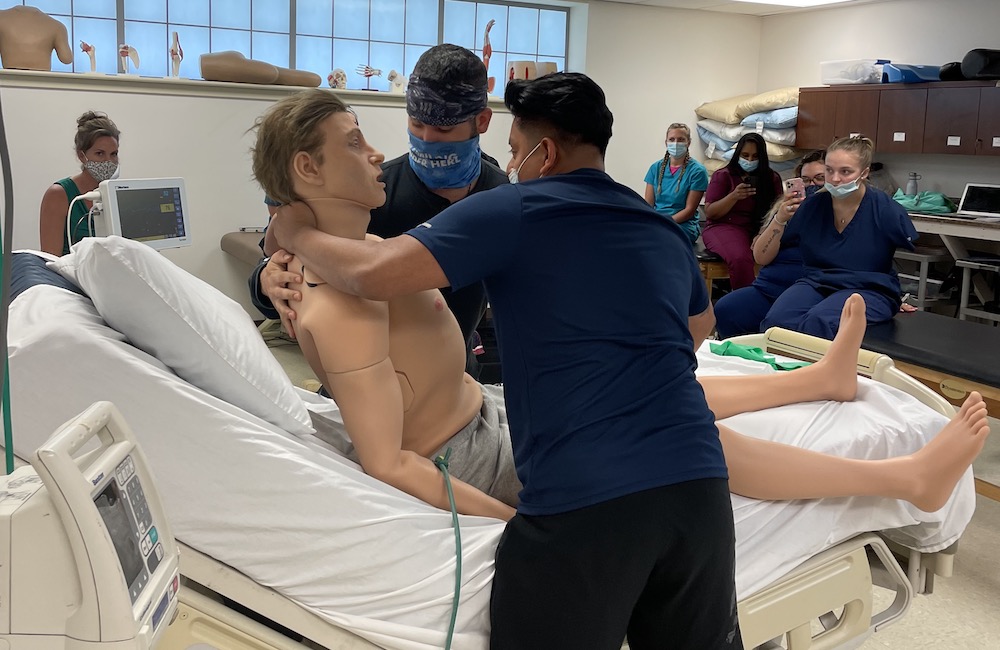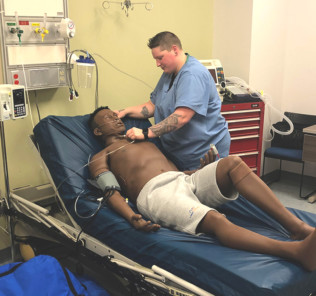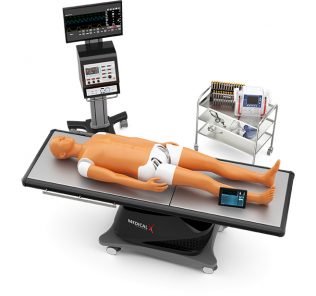Simulation Program Employs Leonardo Manikin to Further Learner Preparation
To improve student performance during clinical rotations, the Physical Therapist Assistant (PTA) program at Horry Georgetown Technical College began looking for new, innovative learning solutions. As the program experienced difficulty in simulating abnormal systemic responses with peers in the classroom, faculty specifically sought out alternative methods of instruction to improve clinical decision-making when sudden events occur during treatment sessions. After exploring clinical simulation products, the program selected MedVision’s adult patient simulator, Leonardo.
Leonardo is designed to support the most challenging tasks in healthcare education, such as for cardiopulmonary resuscitation performance training, intensive care and advanced life-support procedures, using a wide variety of possible medical situations. Specifically, Horry Georgetown Technical College facilitators looked to this mannequin to improve learners’ critical thinking and provide a safe environment in which the students can practice and learn.
“Leonardo was the choice for our program for many reasons. Leonardo has a realistic weight that PTAs need to be able to maneuver, a wide variety of programmable functions, full joint mobility, ability to sit in an upright position for transfers, and ease of use of both the instructor and student computers during simulation activities,” explained Samantha Martel, DPT, PTA program director and professor at Horry Georgetown Technical College.
Sponsored Content:
Upon use, Martel noted that her PTA students expressed the value of the lab activities they experienced with Leonardo. Furthermore, the students appreciated the realism of Leonardo, and felt they were able to have a better understanding of patient responses to mobility in the clinical setting using the mannequin as a resource. Another student takeaway was that they felt less apprehensive with attending a clinical rotation after having clinical simulation experiences. Through use of Leonardo, they felt prepared in how to respond to adverse reactions and emergency situations.
Martel added that, in her experience, clinical simulation has served as a hands-on learning activity that prepares students for the clinic by being able to control the outcomes of the selected intervention. Her students have been able to reflect on their performance through debriefing, and learn from their actions and decisions. Across her program, this has seemingly decreased the anxiety that can be experienced in the real world without having had experience in the didactic environment.
“Simulation is the future of therapy for both didactic training as well as an alternative clinical experience. The technology that can be provided by simulators is effective to prepare students for real-world situations,” Martel said. “We believe simulation in therapy is as crucial as any other training of healthcare professionals.”
More About Leonardo
Sponsored Content:
MedVision’s Leonardo offers extensive functionality, combined with the ability for healthcare educators to utilize their own medical devices. Clinical simulation champions can craft their own scenarios using MedVision’s intuitive software, or by choosing from many others that have been carefully crafted by MedVision simulation specialists. The goal is to enable learners to fully immerse and challenge themselves as they put their individual and team skills to the test in time-critical emergency scenarios.
Features of MedVision’s Leonardo patient simulator include realistic airways, retrograde intubation, head and jaw mobility, pulmonary aspiration, chest rise and fall, airway obstruction, variable bronchi resistance, needle cricothyrotomy, programmable pupils and more. A bedside monitor is another powerful, flexible multifunctional feature with intuitive touch-sensitive controls and high-definition graphics that can be used to complement each training. Other features include:
-
- Wireless connection with 10-hour battery life and fast-charging capabilities
- Realistic weight and height of average American male
- Full articulation of all extremities and head
- Customized skin for ability to write on, easy cleanup of skin with no staining
- Anatomically correct airway
- Difficult airway settings (50% & 100% tongue edema, tongue fallback, pharyngeal obstruction and laryngospasms)
- Use of real defibrillator, vent and anesthesia machines
- Drug-recognition system and realistic drug responses
- Volume and rate sensors of drug administration
- Chest compression with LOCUS machine capabilities
- Secretions, urination and catheterization
- Real-time tracking and analysis of CPR
- Tourniquet/”stop the bleed” sensors
More About MedVision
MedVision is a global company in existence for more than a decade, specializing in designing and manufacturing high-fidelity patient and surgical simulators. MedVision works closely with healthcare professionals around the world to create successful simulation products that impact the quality and safety of patient care and improve patient outcomes. MedVision recently opened their United States headquarters in Tampa, Florida.
The company’s designs and leading-edge technologies define a range of adult, pediatric, neonatal and surgical simulators. MedVision is proud to work closely with healthcare professionals around the world to create successful simulation programs that will impact the quality and safety of patient care and help to improve patient outcomes.
Learn More About MedVision’s Leonardo
Lance Baily, BA, EMT-B, is the Founder & CEO of HealthySimulation.com, which he started while serving as the Director of the Nevada System of Higher Education’s Clinical Simulation Center of Las Vegas back in 2010. Lance is also the Founder and acting Advisor to the Board of SimGHOSTS.org, the world’s only non-profit organization dedicated to supporting professionals operating healthcare simulation technologies. His co-edited Book: “Comprehensive Healthcare Simulation: Operations, Technology, and Innovative Practice” is cited as a key source for professional certification in the industry. Lance’s background also includes serving as a Simulation Technology Specialist for the LA Community College District, EMS fire fighting, Hollywood movie production, rescue diving, and global travel. He and his wife Abigail Baily, PhD live in Las Vegas, Nevada with their two amazing daughters.
Sponsored Content:

















